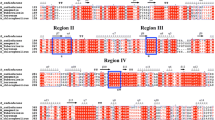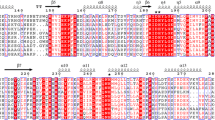Abstract
A gene encoding the trehalose phosphorylase (TreP), which reversibly catalyzes trehalose degradation and synthesis from α-glucose-1-phosphate (α-Glc-1-P) and glucose, was cloned fromThermoanaerobacter tengcongensis and successfully expressed inEscherichia coli. The overexpressed TreP, with a molecular mass of approximately 90 kDa, was determined by SDS-PAGE. It catalyzes trehalose synthesis and degradation optimally at 70°C (for 30 min), with the optimum pHs at 6.0 and 7.0, respectively. It is highly thermostable, with a 77% residual activity after incubation at 50°C for 7 h. Under the optimum reaction conditions, 50 μg crude enzyme of the TreP is able to catalyze the synthesis of trehalose up to 11.6 mmol/L from 25 mmol/L α-Glc-1-P and 125 mmol/L glucose within 30 min, while only 1.5 mmol/L out of 250 mmol/L trehalose is degraded within the same time period. Dot blotting revealed that thetreP gene inT. tengcongensis was upregulated in response to salt stress but downregulated when trehalose was supplied. Both results indicate that the dominant function of theT. tengcongensis TreP is catalyzing trehalose synthesis but not degradation. Thus it might provide a novel route for industrial production of trehalose.
Similar content being viewed by others
References
Singer, M. A., Lindquist, S., Thermotolerance inSaccharomyces cerevisiae: The Yin and Yang of trehalose, Trends. Biotechnol., 1998, 16(11): 460–468.
Elbein, A. D., Pan, Y. T., Pastuszak, I. et al., New insights on trehalose: A multifunctional molecule, Glycobiology, 2003, 13(4): 17R-27R.
Schiraldi, C., Di Lernia, I., De Rosa, M., Trehalose production: exploiting novel approaches, Trends. Biotechnol., 2002, 20(10): 420–425.
De Smet, K. A., Weston, A., Brown, I. N. et al., Three pathways for trehalose biosynthesis in mycobacteria, Microbiology, 2000, 146: 199–208.
Page-Sharp, M., Behm, C. A., Smith, G. D., Involvement of the compatible solutes trehalose and sucrose in the response to salt stress of a cyanobacterialScytonema species isolated from desert soils, Biochim. Biophys. Acta, 1999, 1472: 519–528.
Maruta, K., Mukai, K., Yamashita, H. et al., Gene encoding a trehalose phosphorylase fromThermoanaerobacter brockii ATCC 35047, Biosci. Biotechnol. Biochem., 2002, 66(9): 1976–1980.
Han, S. E., Kwon, H. B., Lee, S. B. et al., Cloning and characterization of a gene encoding trehalose phosphorylase (TreP) fromPleurotus sajor-caju., Protein. Expr. Purif., 2003, 30(2): 194–202.
Xue, Y., Xu, Y., Liu, Y. et al.,Thermoanaerobacter tengcongensis sp. nov., a novel anaerobic, saccharolytic, thermophilic bacterium isolated from a hot spring in Tengcong, China, Int. J. Syst. Evol. Microbiol., 2001, 51: 1335–1341.
Bao, Q., Tian, Y., Li, W. et al., A complete sequence of theT. tengcongensis genome, Genome Res., 2002, 12(5): 689–700.
Zhang, J., Liu, J., Zhou, J. et al., Thermostable esterase fromThermoanaerobacter tengcongensis: High-level expression, purification and characterization, Biotechnology Letters, 2003, 25: 1463–1467.
Sambrook, J., Fritsch, E. F., Maniatis, T., Molecular Cloning: A Laboratory Manual, 2nd ed., New York: Cold Spring Harbor Laboratory Press, 1989.
Zhou, M., Xiang, H., Sun, C. et al., Complete sequence and molecular characterization of pNB101, a rolling-circle replicating plasmid from the haloalkaliphilic archaeonNatronobacterium sp. strain AS7091, Extremophiles, 2004, 8(2): 91–98.
Papadopoulos, N. M., Hess, W. C., Determination of neuraminic (sialic) acid, glucose and fructose in spinal fluid, Arch. Biochem. Biophys., 1960, 88: 167–171.
Rolim, M. F., de Araujo, P. S., Panek, A. D. et al., Shared control of maltose and trehalose utilization inCandida utilis, Braz. J. Med. Biol. Res., 2003, 36(7): 829–837.
Wolf, A., Kramer, R., Morbach, S., Three pathways for trehalose metabolism inCorynebacterium glutamicum ATCC13032 and their significance in response to osmotic stress, Mol. Microbiol., 2003, 49(4): 1119–1134.
Author information
Authors and Affiliations
Corresponding authors
Rights and permissions
About this article
Cite this article
Ren, Y., Dai, X., Zhou, J. et al. Gene expression and molecular characterization of a thermostable trehalose phosphorylase fromThermoanaerobacter tengcongensis . Sci. China Ser. C.-Life Sci. 48, 221–227 (2005). https://doi.org/10.1007/BF03183615
Received:
Revised:
Issue Date:
DOI: https://doi.org/10.1007/BF03183615




